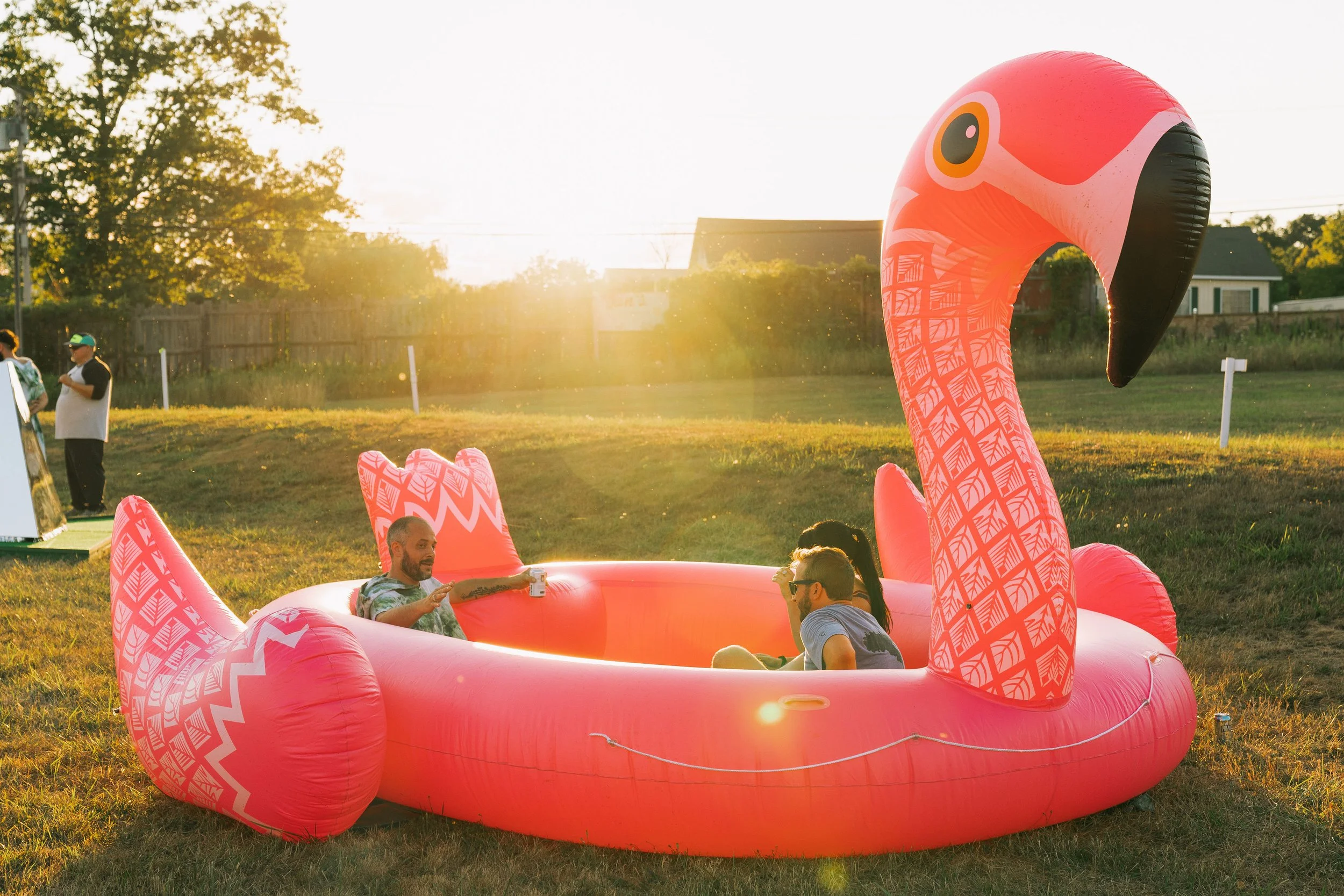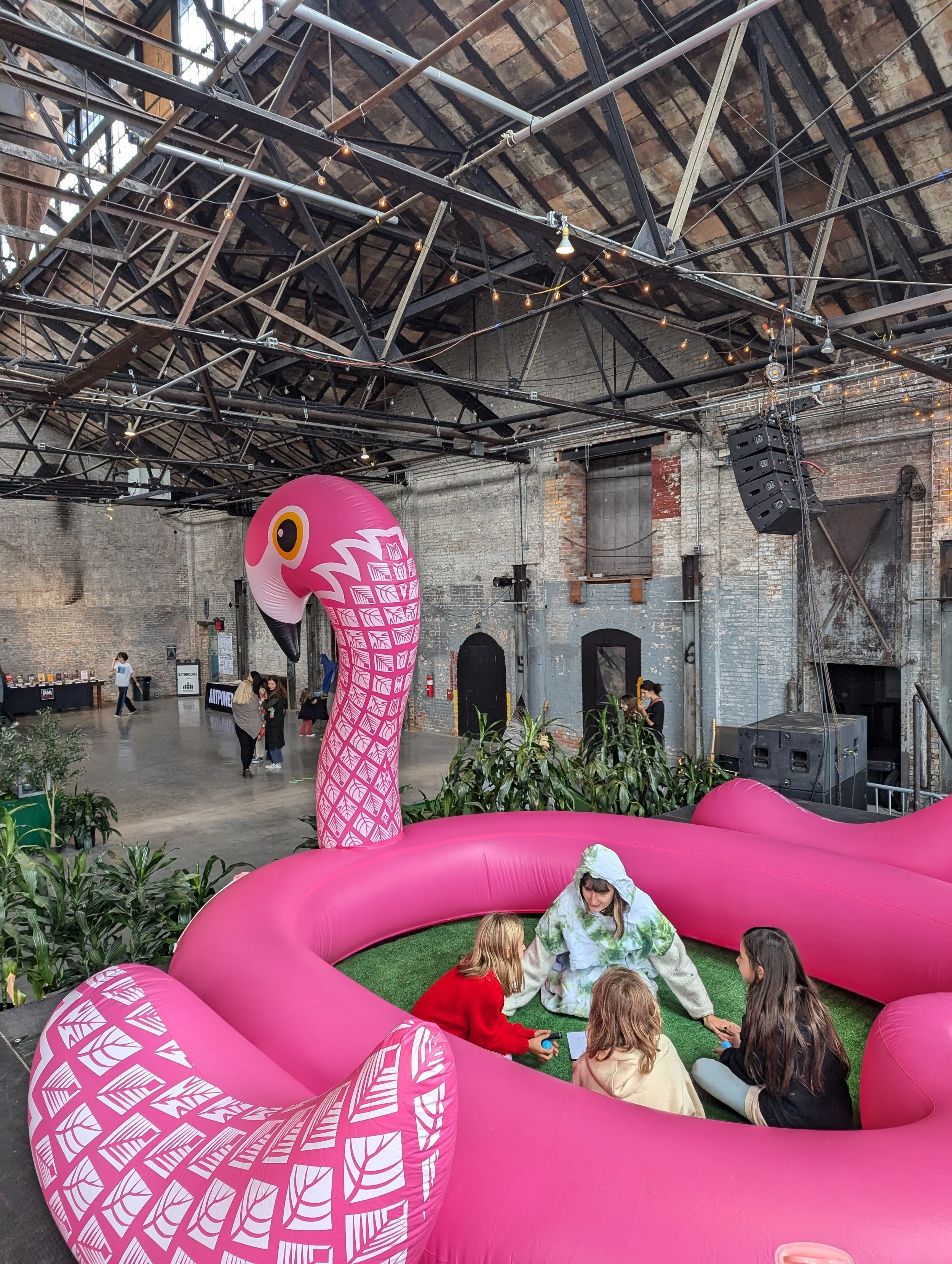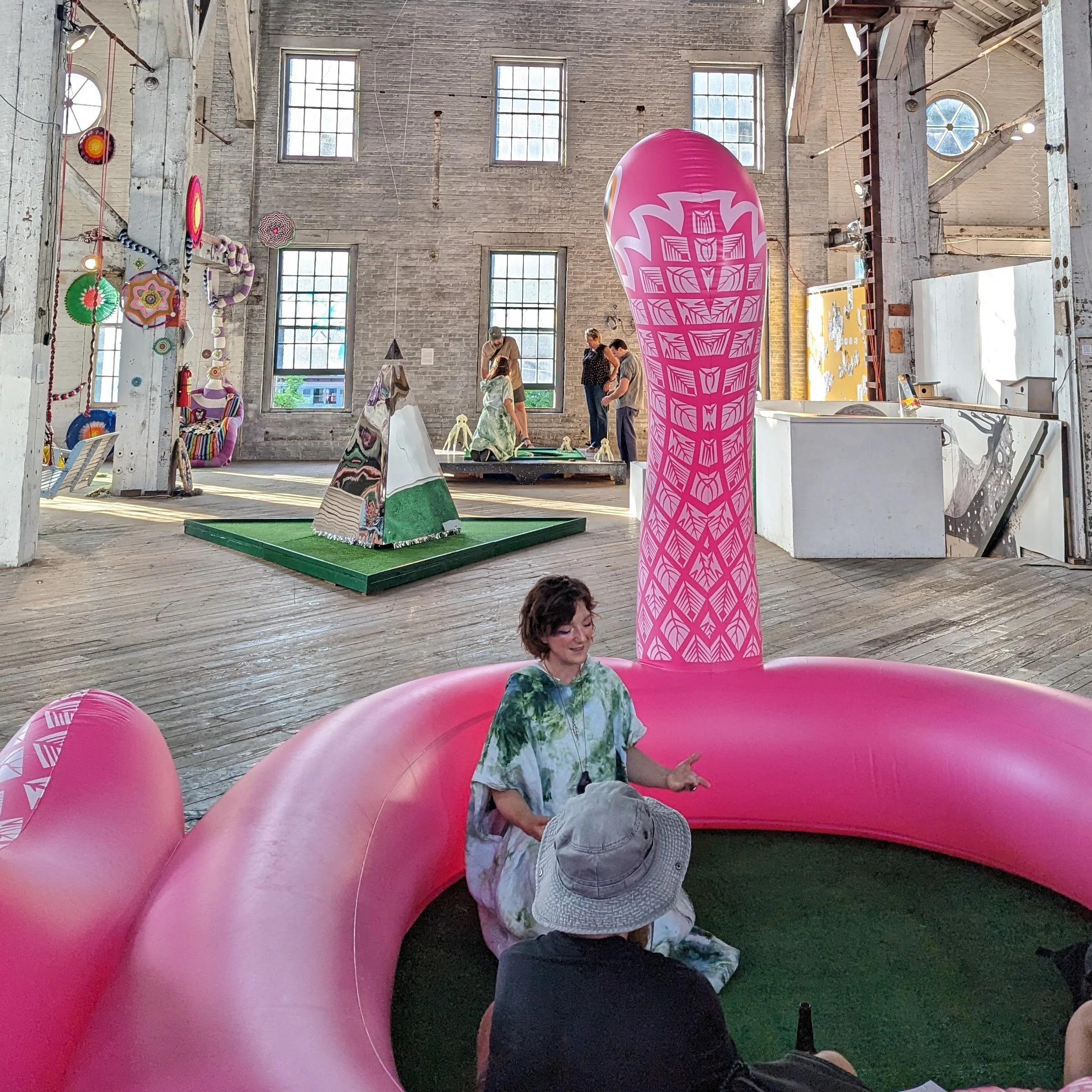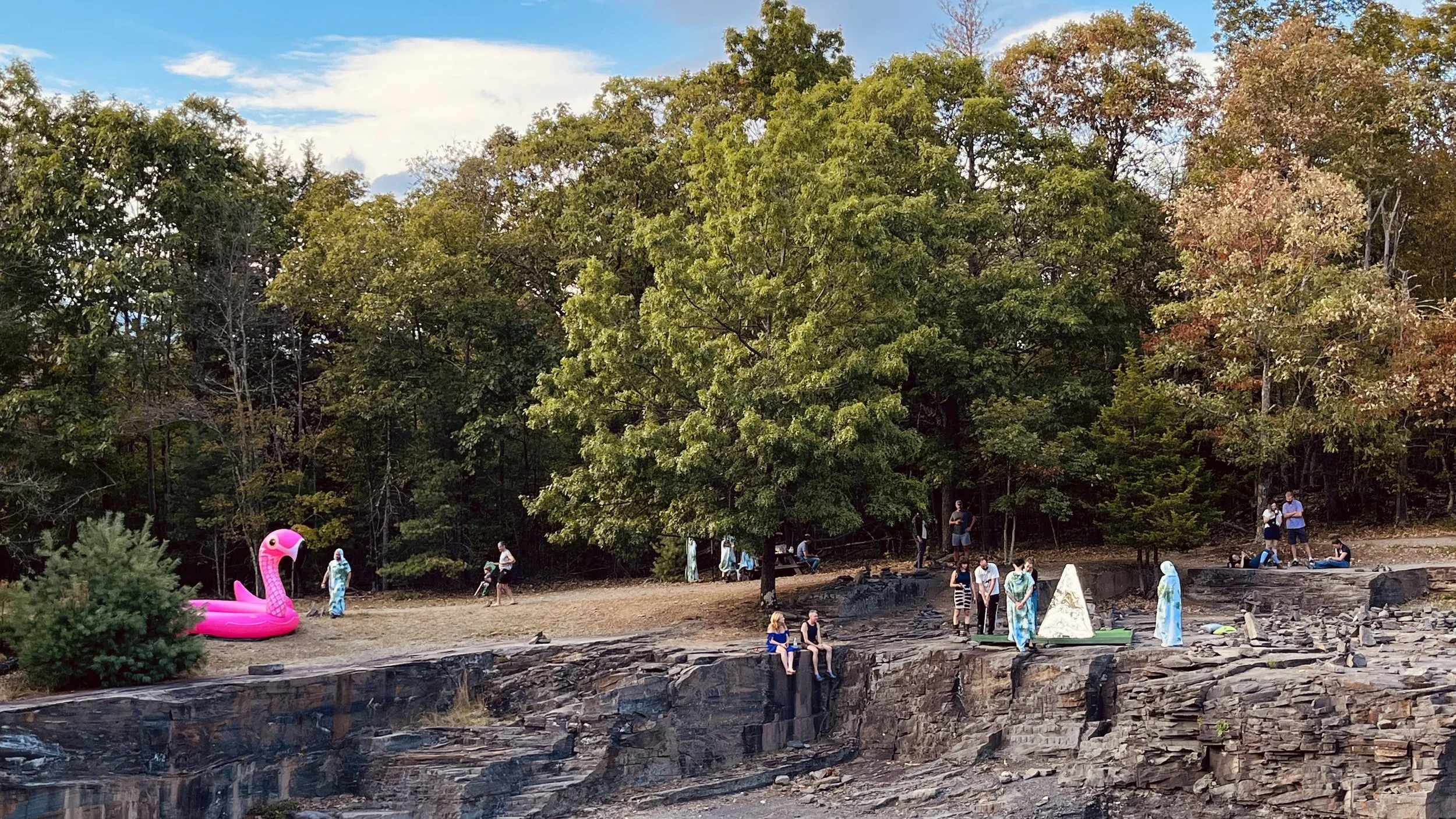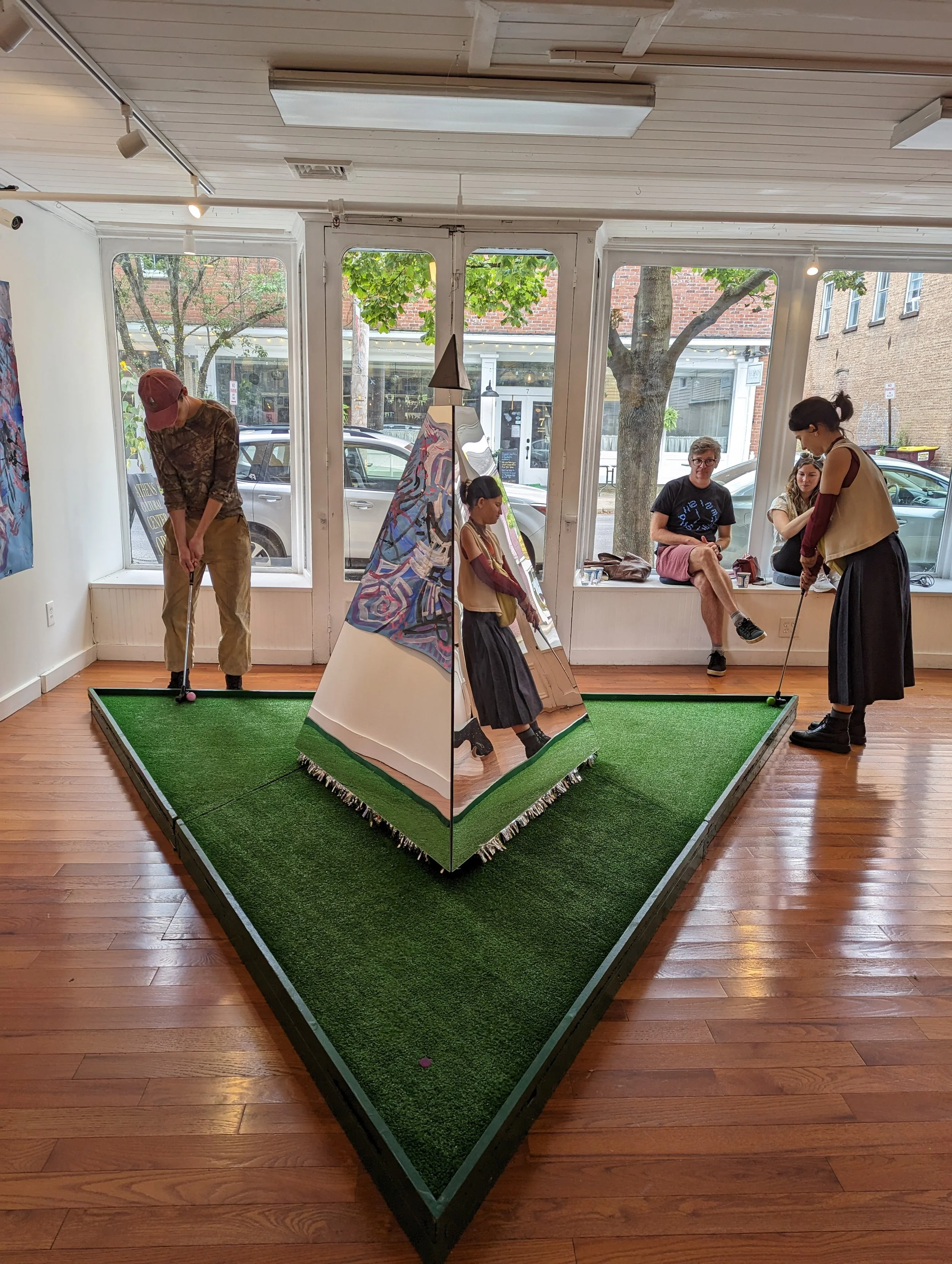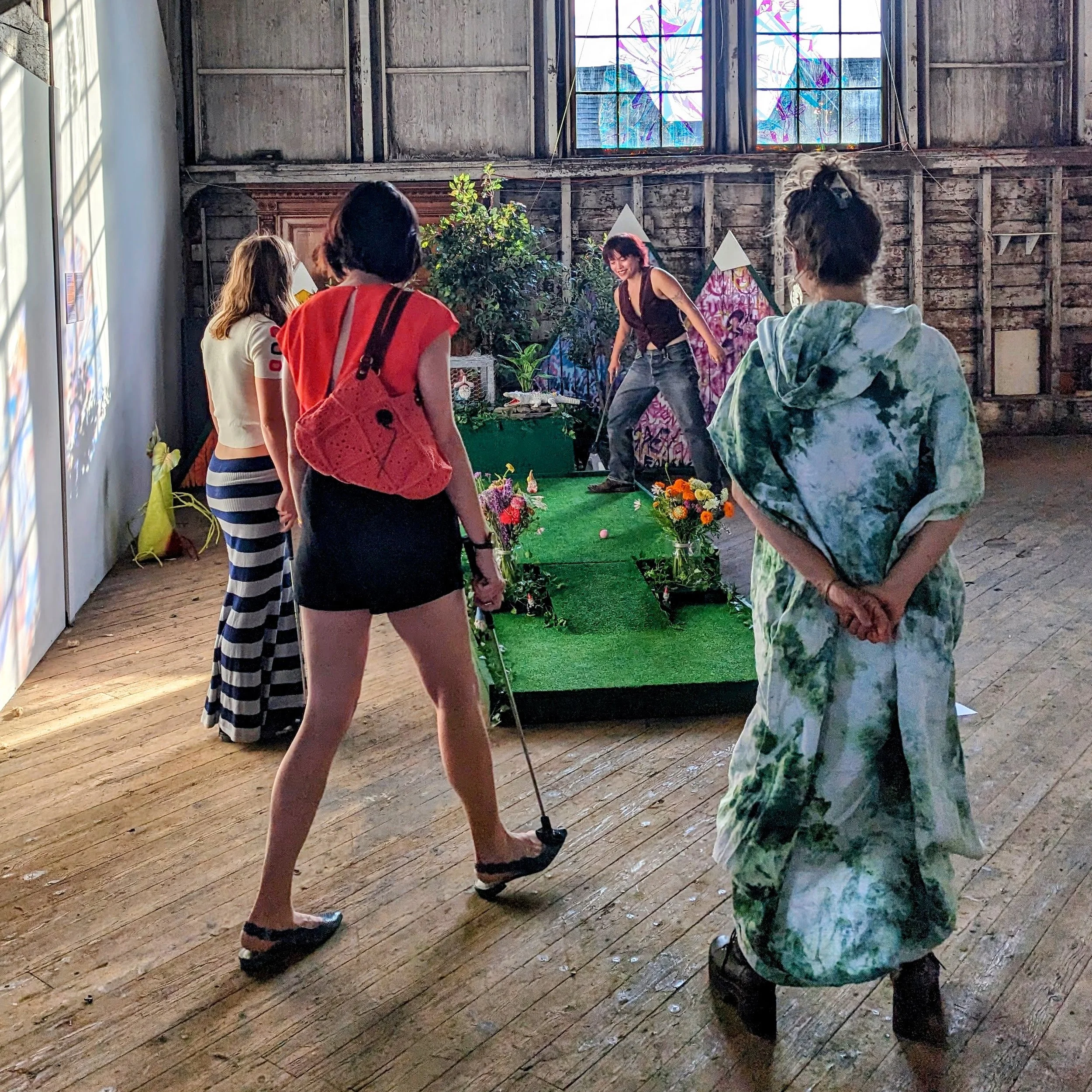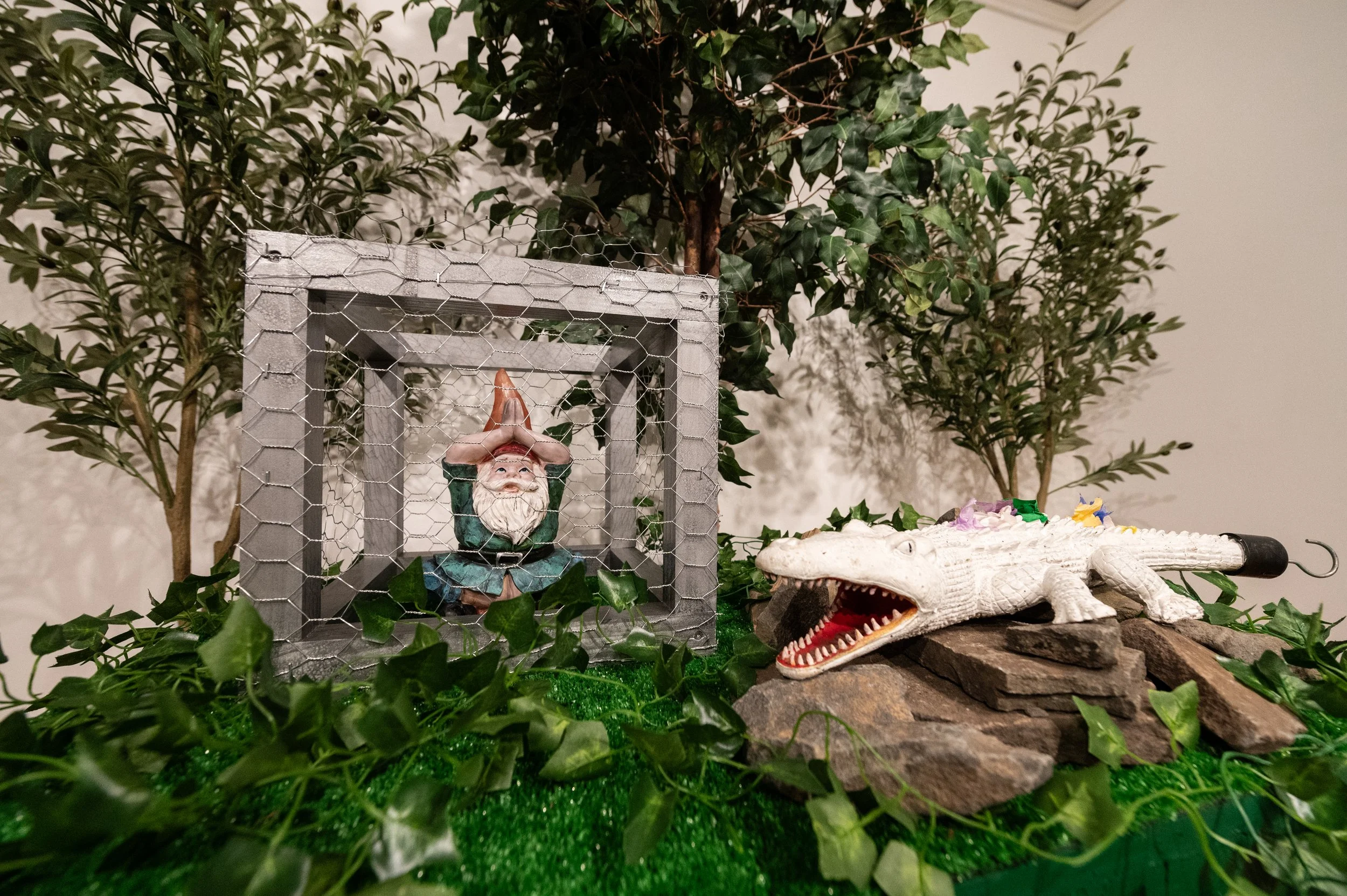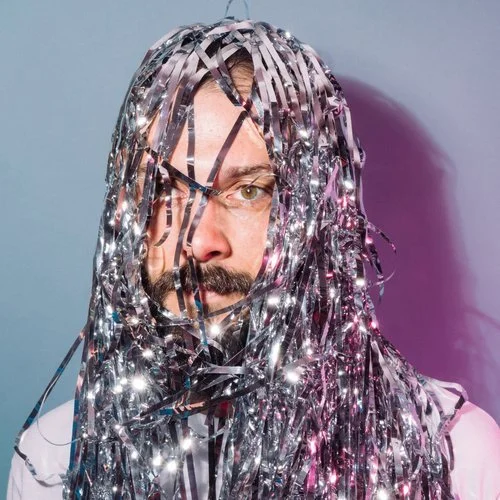
About
Lucid Dream Minigolf: In Search of Lost Time is a traveling, existential, heartfelt, pop-up minigolf course and interactive theater company.
Can whimsy be deep? Can silly be sentimental? Our project aims to spark a sense of delight and playfulness, creating a storytelling experience that uses the medium of minigolf as performance theater and interactive narrative. The story explores deeper themes of shared experience, of overcoming a sense of being behind in one's life, of feeling lost, and finding resiliency.
The main character, The Mutant Swamp Monster (a bioluminescent pet alligator flushed down the toilet by a neglectful owner in Manhattan who then swam their way up the Hudson in search of refuge), has had a hard past couple of years. They aren't where they thought they would be at this point in their mid-swampy-monster-life. Driven by the fear of being behind, the Mutant Swamp Monster has stolen Time the Gnome of Infinity in a misguided attempt to fill that hole inside themselves. Time is a magical gnome responsible for the flow of time itself. The land of Lucid Dream Minigolf is in peril! Without Time our land will grow stagnant and lifeless. You as a player must go on a quest to search for and free Time by playing holes that represent your own autobiographical past (The Pyramid of What Was), present (The Abyss of What Is), and future (The Winds of What May Be).
Each group of players is paired with a green cloaked actor known enigmatically as a “Guide”—a multiclass blend of wizard, narrator, and caddie. A Guide performs a scripted narrative and improvises based on what players say and the choices they make while playing. There is plenty of putting and obstacle-course shenanigans, but the playing is also contemplative with players sharing personal experiences and reflecting on their life stories as they putt.
Take something familiar, fun, and accessible to all (minigolf), flip it upside down, and imbue it with interactive art pieces, guided imagery, and a game that playfully engages with deeper ideas and science designed to cultivate imagination. It’s the power of transcendental humanism through the gonzo absurdity of performance theater putt-putt. If Station Eleven, Sleep No More, the science of imagination, and an abandoned minigolf course all had a baby together, that baby would be this project.
It’s no coincidence that minigolf first became popular during the fallout of the Great Depression and, in a very small way, was part of desegregating public places as a result of its whimsical escapism and general accessibility. At its core, Lucid Dream Minigolf is a game designed to help players collectively process and question the absurd to find camaraderie and solace amidst hardship. Lucid Dream Minigolf is a call to play in times of darkness.
This game isn't what you think it is and neither is your life…
Why are you playing by the rules you inherited?
Prologue: from a pandemic face shield factory to an absurd minigolf course
From the fire and ashes of disaster grew the seeds of friendship and minigolf. When COVID-19 first hit in 2020, we helped to lead efforts to make face shields for a local hospital and nursing homes in the Hudson Valley, coordinating efforts across makerspaces, sourcing material from the local library system, and turning an art center, the Basilica Hudson, into a mass assembly line.
After months of making face shields, we were happy to have served but feeling a little ragged. We needed a mental break and wanted a creative project that was purely silliness. The idea of building a gonzo minigolf course was born! Bren began designing holes and reaching out to makerspace and artist friends to turn his 8’x10’ deck into a minigolf course. Liam quickly came on board and began to help develop the characters, story, and performance theater aspects. After having so much fun creating three holes in such a small space, we decided to share it with others.
We ended up rigging out Bren’s apartment with the lights and fog machine from the Avalon Lounge rock club in Catskill, and running it as an underground performance piece, creating an anonymous Instagram account, mailing golden tickets to interested players, and developing an hour long interactive narrative to play through.
On the Road
After the first underground version of Lucid Dream Minigolf in a tiny apartment, word of mouth spread, and, at the encouragement of others, we decided we should keep playing. But how? What would be simultaneously more fun and more meaningful? We decided to hit the road and turn Lucid Dream Minigolf into a traveling theater company.
We spent 2021 working with friends to design and build new props, costumes, and courses, applying for grants, recruiting a ragtag company of makers, artists, and actors, and adding a 15-ft inflatable flamingo as a mental time traveling chariot through the game. By the summer of 2022, the Mindwandering Flamingo was airborne. The world’s first traveling existential minigolf course and interactive theater was taking flight.
From the middle of the woods, an alleyway, a dive-bar, and a drive-in theater to gallery spaces, artist residencies, festivals, and sculpture parks, from Prattsville to Wassaic, Athens to Brooklyn, we have traveled across Hudson Valley and NYC:
We have traveled for a reason. The mobile and pop-up nature of this piece stands in contrast to the stasis and confinement of lockdown during the pandemic. Emerging from lockdown has been a time to delight in motion and the bittersweetness of how fleeting life can be. Dreams were never meant to be static or last forever, they were meant to move us.
You can see a full list of all the places we have traveled to and performed on our Play page.
Fifteen performances of In Search of Lost Time and four years after we started minigolf, we returned to Basilica Hudson—the place that initially fostered our friendship as an ad hoc face shield factory, a creative campfire to gather around in the darkness of the pandemic.
Returning to Basilica brought the project creatively full circle; there couldn't be a more fitting ending to the production of the In Search of Lost Time storyline.
Yet, in a world that still feels jagged and fragile and is no stranger to suffering and conflict, it could still use a little more whimsy and a lot more warmth and mental agility. The need for play, for imagining new perspectives and possibilities, has never been greater nor more challenging.
Our sincere hope is that in some small way the existence of this ridiculous minigolf project and its story will inspire more collaborative imagination and playfulness, an example of the potential of games and art to help us create new possibilities and connections in an absurd world, the power of coming together to collectively shed a little bit of light into the darkness.
Biographies
Brendan Bo O’Connor | Bren (Creator & Director)
a cognitive sicientist and outsider artist. He runs the Imagination & Moral Cognition Lab at SUNY Albany as an associate professor. With a knack for DIY arts and crafts, he is a member of the Purpose Makerspace and a performer and parade marshal with Processional Arts Workshop
Liam Singer (Co-creator)
is a composer, curator, and performer. He has enjoyed a long history of elevating others through whimsy. With his wife Laura, he owns and operates The Avalon Lounge, a live performance venue/dance club/Korean kitchen.
Bren and Liam conceived of a mobile experimental minigolf course. Bren led course design and production with Liam providing critical inspiration and support. Together, along with contributions and performances from a lot of loving and creative friends, we are Lucid Dream Minigolf.
Scientific References
Lucid Dream Minigolf draws inspiration from all kinds of people, stories, art, places, experiences, and ideas, some of which come from the science of imagination, memory, and mental time travel. If you wanted to dig deeper into the literature, here are some good places to start:
Addis, D. R., Wong, A. T., & Schacter, D. L. (2007). Remembering the past and imagining the future: common and distinct neural substrates during event construction and elaboration. Neuropsychologia, 45(7), 1363-1377.
Bulley, A., Redshaw, J., & Suddendorf, T. (2020). The Future-Directed Functions of the Imagination: From Prediction to Metaforesight. The Cambridge handbook of the imagination, 425.
Christoff, K., Irving, Z. C., Fox, K. C., Spreng, R. N., & Andrews-Hanna, J. R. (2016). Mind-wandering as spontaneous thought: a dynamic framework. Nature Reviews Neuroscience, 17(11), 718-731.
D'Argembeau, A., Lardi, C., & Van der Linden, M. (2012). Self-defining future projections: Exploring the identity function of thinking about the future. Memory, 20(2), 110-120.
Drake, J. E., & Winner, E. (2013). How children use drawing to regulate their emotions. Cognition & emotion, 27(3), 512-520.
Dubourg, E., & Baumard, N. (2021). Why Imaginary Worlds?: The psychological foundations and cultural evolution of fictions with imaginary worlds. Behavioral and Brain Sciences, 1-52.
Fowler, Z., Palombo, D., Madan, C. R., & O’Connor, B.B. (2024). Collaborative imagination synchronizes representations of the future and fosters social connection in the present. Proceedings of the National Academy of Sciences, 121(25).
Genuth, A., & Drake, J. E. (2021). The benefits of drawing to regulate sadness and anger: Distraction versus expression. Psychology of Aesthetics, Creativity, and the Arts, 15(1), 91.
Jing, H. G., Madore, K. P., & Schacter, D. L. (2016). Worrying about the future: An episodic specificity induction impacts problem solving, reappraisal, and well-being. Journal of Experimental Psychology: General, 145(4), 402.
McAdams, D. P., & McLean, K. C. (2013). Narrative identity. Current directions in psychological science, 22(3), 233-238.
Menninghaus, W., Wagner, V., Hanich, J., Wassiliwizky, E., Jacobsen, T., & Koelsch, S. (2017). The distancing-embracing model of the enjoyment of negative emotions in art reception. Behavioral and Brain Sciences, 40.
Meyer, M. L., Hershfield, H. E., Waytz, A. G., Mildner, J. N., & Tamir, D. I. (2019). Creative expertise is associated with transcending the here and now. Journal of personality and social psychology, 116(4), 483.
Nussbaum, M. (1997). Poetic justice: The literary imagination and public life. Beacon Press.
O’Connor, B., & Fowler, Z. (2023). How Imagination and Memory Shape the Moral Mind. Personality and Social Psychology Review.
Palombo, D. J., Keane, M. M., & Verfaellie, M. (2015). The medial temporal lobes are critical for reward‐based decision making under conditions that promote episodic future thinking. Hippocampus, 25(3), 345-353.
Schacter, D. L., & Addis, D. R. (2020). Memory and imagination: Perspectives on constructive episodic simulation. The Cambridge Handbook of Imagination, A. Abraham, Ed.(Cambridge University Press, Cambridge, England, 2020), 111-131.
Rovelli, C. (2019). The order of time. Penguin.
Seli, P., Risko, E. F., Smilek, D., & Schacter, D. L. (2016). Mind-wandering with and without intention. Trends in cognitive sciences, 20(8), 605-617.
Szpunar, P. M., & Szpunar, K. K. (2016). Collective future thought: Concept, function, and implications for collective memory studies. Memory Studies, 9(4), 376-389.
Vollberg, M.C., Gaesser, B., & Cikara, M. (2021) Episodic simulation increases empathy for in-group and out-group members. Cognition, 209, 104558.
Weisberg, D. S. (2015). Pretend play. Wiley Interdisciplinary Reviews: Cognitive Science, 6(3), 249-26.
Acknowledgements
It is with the deepest appreciation and gratitude that we thank the following friends and supporters of the course. Without their time, talent, tools, and creative passions, a whimsical traveling minigolf course in the Hudson Valley and Catskills in all likelihood would not exist. From the bottom of our hearts, our sincere thanks to everyone that helped including, but not exclusively:
Building
Ben Seretan | @benseretan: collective memory sound design
Processional Arts Workshop | @processional_arts: consultants
Becca Van K | @beccavank: flamingo saddles
Grace Lang | @grooseling: mountain painting
Ramiro Davaro-Comas | @ramirostudios: mountain painting
Casson Kennedy | @cassnknndy: course construction and workshop facilities
Ashton Dame | @kreaturekastle: illustration and cartography
Lucy Bohnsack | @lucybohnsack: costuming
Amelia Toelke | @ameliatoelke: pyramid construction, typesetting
Peter Madsen: pyramid construction and facilities
ProPrinters | @proprinters: field guide printing
Tech Valley Center of Gravity | @techvalleycog: 3D printing
Brandon Gamm | @brandon_gamm: 3D printing
Erik Morrison: construction assistant
Josh Olsen | @olsenjosh: construction assistant
Sophia Taylor | @sophiatayylor: spirit orb charting
Sammy Maine | @sammymaine: copy editing
Purpose Makerspace | @purposecooperative: facilities
Emma Anne Johnson | electrical engineering
Performing
Catie Friel | @selfsamesould
Kendra McKinley | @kendra_mckinley
Rebecca R. Borrer | @rrb.life
Christine Vines | @christine_vines
Andrew Emge | @weymoso
Alex Daud | @daud.ac
Casey Robertson | @caseyrobertson_
Delano Montgomery | @topquialitymanfriend
Jenny Allen | @jennielallen
Dylan Nowik | @dylannowik
Delano Montgomery | @topquialitymanfriend
Lucy Bohnsack | @lucybohnsack:
Casey Taylor | @caassey
Sammy Maine | @sammymaine
Derek James Smith | @constellationcatskill
Funding
This project has been supported by
Awesome Foundation NYC | @awesomefound.nyc:
CREATE Council of Greene County | @create.council:
Alliance of Resident Theatres/New York | @artny72
New York Council on the Arts | @nyscouncilonthearts:

